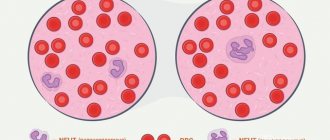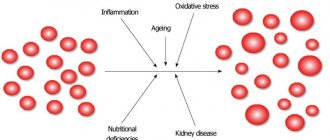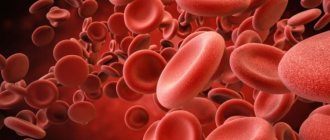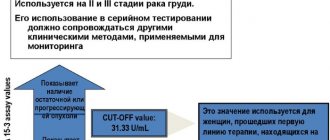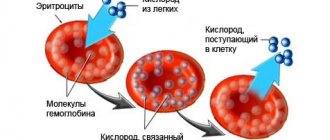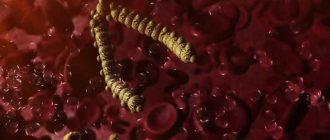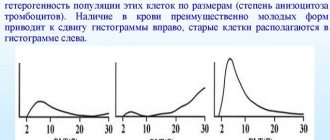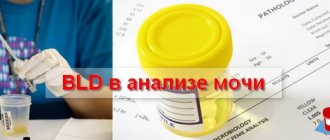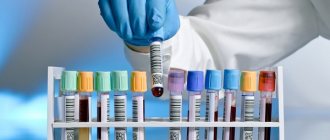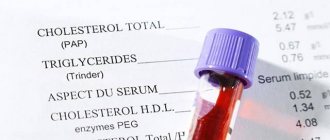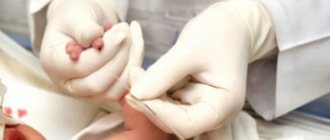A general blood test is one of the simplest, most inexpensive and at the same time informative laboratory tests, allowing the doctor to determine the presence of pathological processes. Most people are familiar with the main parameters measured during this type of diagnosis and understand what they mean.
But for many, an indicator such as GRA in a blood test is simply an abbreviation that does not carry any meaning. But in fact, its deviations, identified when deciphering the examination results, often indicate the presence of diseases, some of which pose a serious threat to human health and life.
What are immature granulocytes in a blood test?
Have you been struggling with CHOLESTEROL for many years without success?
Head of the Institute: “You will be amazed at how easy it is to lower your cholesterol just by taking it every day.
Granulocytes are a subgroup of granular leukocytes, which include neutrophils, eosinophils and basophils. Their norm is 50-80% of all white blood cells, in quantitative terms - 2-7X10⁹ per liter. Under a microscope you can see granules or grains in them, hence the name. Granulocytes are produced in the bone marrow and have a short lifespan after release into the tissue - up to three days.
They are divided into mature (or segmented), not fully mature (or band) and immature granulocytes (or young). The life of rod forms in the blood does not last long, and almost immediately they become mature: the nucleus divides into segments, and they turn into segmented forms. In a blood test, neutrophils are in order (from left to right): young, band and segmented. The increase occurs with a shift to the right or left.
Our readers successfully use Aterol to lower cholesterol. Seeing how popular this product is, we decided to bring it to your attention. Read more here...
Normally, there are practically no young granulocytes in the blood, although the presence of immature forms in newborns and during pregnancy is an exception. The presence of immature granulocytes in the blood determines the development of pathology. If young neutrophils are present in greater than normal numbers, this may indicate an inflammatory process or infection. In this regard, early diagnosis of infectious diseases and sepsis is possible.
Neutrophil norm
Since immature granulocytes do not live long in the blood and mature quickly, their number is small. The norm of band neutrophils for adults is 1-5%, the norm of segmented neutrophils is from 45 to 65% of the total number of leukocytes.
There are fewer neutrophils in the blood of a child than in adults. Up to a year, immature granulocytes are present. The norms for children are as follows:
- up to a year: mature – 15-30%, immature – up to 4%;
- from 1 to 6 years: mature – 25-60%, immature – up to 5%;
- from 7 to 12 years: mature – 35-65%, immature – up to 5%;
- from 13 to 15 years: mature – 40-65%, immature – up to 6%;
- from 15 years: mature – 45-70%, immature 1-5%.
Reasons for the increase in young granulocytes
If neutrophils are elevated, a shift to the left is usually observed in the leukocyte formula. That is, immature and band-nuclear granulocytes are present in the blood. This indicates the development of a pathological process in the body. That is why the body begins to produce neutrophils in large quantities in order to protect against infection. Hence the large percentage of young forms. The reasons for the increase in the number of immature neutrophils are numerous. An increase in their level can be physiological:
- in newborns;
- during pregnancy;
- under stress;
- after meal;
- during physical activity.
An increase in the level of young granulocytes is observed in the following pathologies:
- pneumonia, peritonitis, osteomyelitis, appendicitis, meningitis, pyelonephritis, cholera, sepsis, tonsillitis, thrombophlebitis, cholecystitis, scarlet fever, otitis media;
- purulent processes: abscesses and phlegmon;
- typhoid fever, tuberculosis, hepatitis, malaria, measles, influenza, rubella;
- chronic skin diseases: psoriasis, some types of dermatitis;
- acute bleeding;
- burns;
- intoxications: lead poisoning, insect bites, foreign protein, diabetic acidosis, uremia, Cushing's syndrome, etc.;
- malignant diseases;
- systemic diseases;
- gout;
- myocardial infarction, pulmonary infarction;
- gangrene;
- chronic myeloplastic diseases;
- serum sickness;
- after taking certain medications: androgens, lithium preparations, glucocorticosteroids.
A particularly sharp shift to the left in the leukocyte formula is observed in myelomonocytic leukemia, as well as in purulent processes. The number of rod and immature forms increases sharply. Neutrophil granulocytes can have changes not only of a quantitative, but also of a qualitative nature, especially with severe intoxication and severe purulent-inflammatory processes. With strokes, burns, heart attacks and trophic ulcers, the increase in neutrophils occurs less frequently.
The reasons for the increase in immature forms of neutrophils in children are most often the following:
- otitis media, tonsillitis, pneumonia and other acute infections;
- purulent processes;
- acidosis;
- leukemia;
- hemolytic anemia;
- trophic ulcers;
- third and fourth degree burns.
Neutrophils
When working to eliminate pathogens, leukocytes quickly lose their potential and soon become unviable. In order to avoid this deficiency, the bone marrow produces new portions of granulocytes. These cells are immature, but they are able to perform a protective function. A general blood test allows you to determine the number of immature (young) neutrophils, and draw a conclusion about the seriousness and danger of the inflammatory process.
Types and functions
This type of granulocyte is the most numerous of the white blood cells. Their percentage is normally at least 45%, but should not exceed 75%. In blood taken from peripheral vessels (capillaries) in healthy adults and children, the presence of segmented and band-type neutrophils can be determined.
The first granulocytes are characterized by the presence of a small nucleus and a fairly large volume of cytoplasm. The nucleus contains 5–6 segments. The second type of these cells is a younger form of white blood cells. Their core resembles the shape of a horseshoe, and the normal rate for adults is not more than 6%. Normal values for newborns are significantly different - they increase to 20%, and only with age there is a tendency for these blood cells to decrease.
The main function of neutrophils is phagocytosis - searching, capturing and digesting foreign cells. The large number of grains that make up these granulocytes ensures the destruction of pathological particles, which leads to the formation of pus in the area with the inflammatory process. Therefore, the pus-like substance largely consists of tissue cells that have undergone a process of destruction. At the same time, it contains infectious agents in combination with fluid formed as a result of inflammation.
Reference! These blood cells are formed in the bone marrow in about 10 days and then enter the blood. Their life cycle does not exceed 10 hours, and the appearance of immature neutrophils in the body is indisputable evidence of the occurrence of pathological processes.
Normal white blood cell counts for a healthy adult
Reasons for deviation of neutrophils from the norm
The concentration of neutrophil blood cells may vary relative to normal levels. This is due to the specific characteristics of the diseases, and some diseases are characterized by increased values, and some by decreased ones. A pathology in which the neutrophil count is reduced is called neutropenia, that is, their level becomes less than 1.7 * 109/l.
This decrease is due to:
Ultrasound of the hepatobiliary system
- radiation sickness (including long-term chemotherapy);
- oncological diseases of the bone marrow;
- anemia (decrease in the level of red blood cells) of various types;
- infectious diseases - typhoid fever, malaria;
- excessive exhaustion of the human body;
- autoimmune pathologies;
- diseases or removal of the spleen.
In addition to the above, neutrophils decrease with viral infectious diseases - influenza, rubella, hepatitis and AIDS, as well as with long-term use of drugs that have increased toxicity. There are cases of congenital neutropenia, the so-called Kostman syndrome. The pathology is autoimmune-recessive in nature and most children die in the first years of life. This is due to the lack of functioning of cellular immunity, which makes the body vulnerable to multiple pathogens.
If the transcript of a general blood test shows a significant excess of normal neutrophil levels, then, most likely, sepsis is currently developing in the body. This pathology is often a consequence of infectious diseases and is considered a very life-threatening complication. With sepsis, such a large number of pathogenic microbes are formed in the body that the body itself is not able to cope.
Only timely administration of antibacterial therapy can save a person from this disease and its negative consequences.
Also, this type of granulocytes can be increased during the formation of tumors. Then immature neutrophils appear in the blood in large numbers. But at the same time, neutrophilia - an increase in the concentration of neutrophils in the peripheral blood does not mean one hundred percent presence of cancer. Sometimes certain medications or exposure to animal poisons can increase the level of neutrophil granulocytes.
An excess of the norm of these blood cells is often observed during heart attacks, rheumatoid arthritis, gangrene and skin diseases. It should be noted that there are quite a lot of diseases characterized by an increase in the concentration of neutrophil GRA in human blood. Therefore, to establish the correct diagnosis, decoding must be carried out by an experienced specialist who can compare all the indicators being studied and draw a conclusion based on an objective look at the examination results.
Granulocytes
Granulocytes (granular leukocytes) are a group of white blood cells that contain granules in their cytoplasm. A reduced or increased amount of this component in the blood is a sign of the development of a certain pathological process, but this can only be established through diagnostic measures.
Leukocytes, that is, white cells, in the blood are divided into two types - granulocytes and agranulocytes. The first group includes components that include cytoplasm with granules. Segmented granulocytes are very important for the body, as they are the first line of defense against microbes: when a focus of inflammation is formed, it is the granulocytes that begin the body’s immune response.
The reasons that granulocytes are increased or decreased may be not only pathological processes, but also environmental factors. Thus, deviations from the norm can be caused by taking medications or frequent stress. It is very important to monitor these indicators in the blood of children or adults, as an imbalance can lead to quite serious complications.
Where to get tested
To determine the number of polymorphonuclear cells, a medical specialist prescribes a medical test. Most often, a test for the number of granulocytes is performed using the leukocyte formula, which is the percentage of white cells in the liquid connective tissue and refers to a constant value.
This type of laboratory examination can be done in any private clinic by collecting liquid connective tissue from the venous bed.
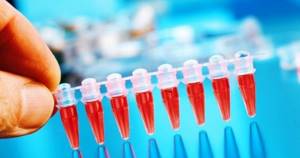
The cost of the analysis will vary from 125 rubles. up to 160 rub. depending on the level of qualifications of medical personnel and the status of the institution.
General practitioners also prescribe a clinical blood test to determine the amount of GRA. A basic study can be done in any multidisciplinary specialized treatment and preventive institution for the provision of outpatient medical care. In this case, a laboratory technician takes capillary blood from the ring finger, and the procedure is free.
Education and life cycle
Granulocytes are formed in the bone marrow: the cells divide within four days, after which their morphological maturation occurs. This stage lasts no more than five days. After the cells enter the bloodstream, they are divided into two types: parietal, which are temporarily attached to the walls of blood vessels, and actively circulating. They circulate through the circulatory system for about a week, then exit into the tissue. Here the cells live for about two days, after which their life cycle is completed.
The number of granulocytes in the blood is about 60% of the total number of white cells. These components, in turn, are divided into subspecies.
Thus, the following cells belong to granulocytes:
- Neutrophil granulocytes are the largest number of them in the blood of an adult or child. In essence, neutrophil granulocytes neutralize pathogenic organisms by “sacrificing” themselves.
- Basophils - cells instantly react to allergens, accelerate blood circulation and direct a large amount of fluid to the affected area.
- Eosinophilic granulocytes – act on parasitic organisms and prevent the development of an allergic reaction. Among the white bodies, these are the smallest and most mobile bodies.
If certain granulocytes are low or high, this can negatively affect the functioning of the body, for example, when pathogenic organisms enter, the immune response may be too weak, which will lead to serious complications.
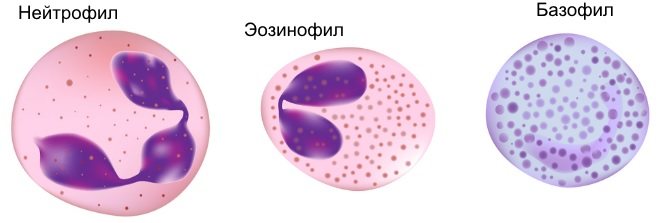
Types of granulocytes in the human body and their functions
GRA (in a blood test this is an indicator of shaped white cells) have specific granules in the semi-liquid contents of the cells, which are represented by lysosomes and pyroxisomes. Granular leukocytes are the most numerous representatives of white cells of liquid connective tissue and are secreted by the organ of the hematopoietic system that carries out hematopoiesis from a single precursor cell.

Once in the hematocirculatory pathway, granular leukocytes are divided into macrophages and parietal pools. This state for granulocytes is the primary step before leaving the channel of liquid connective tissue into the organs and systems of the body, where white cells live for about 48 hours. The main feature of granular leukocytes is a reaction to normal staining during laboratory testing.
This allows granulocytes to be divided into:
- segmented neutrophils;
- eosinophilic leukocytes;
- granolocytic basophils.
| Name | Peculiarities | Functions |
| Neutrophil leukocytes |
|
|
| Segmented eosinophils |
|
|
| Granulocytic basophils | contain in large quantities:
|
|
Possible reasons for deviation from the norm
The reasons for the increase in the number of white cells in the blood may be the following:
- parasitic infections;
- acute inflammatory processes;
- infectious diseases;
- pathological processes that are accompanied by tissue necrosis;
- allergic reactions;
- intoxication of the body;
- acute hemorrhages;
- diseases of the hematopoietic system;
- oncological diseases;
- inflammatory processes in the gastrointestinal tract;
- Hodgkin's syndrome;
- endocrine disorders;
- diseases of the cardiovascular system;
- hemolytic anemia;
- infectious processes of non-parasitic nature.
Taking certain medications can also cause granulocytes in the blood to be higher than normal. As a rule, after stopping the medications, the indicators return to normal.
The reasons that granulocytes in the blood are below normal are as follows:
- allergic reactions;
- gastroenterological diseases;
- systemic or autoimmune diseases;
- various types of anemia;
- scarlet fever;
- rheumatism;
- sarcoidosis
It should also be taken into account that when interpreting the analysis, other blood parameters are also taken into account, so it is not recommended to interpret the data yourself: only a doctor can do this correctly.
Structure, norms and purpose of basophils
Basophilic granulocytes are a type of small white blood cell with a large nucleus and a small amount of cytoplasmic fluid. The number of nuclear segments of these bodies is even less than in neutrophils and eosinophils. When entering the blood of peripheral vessels, the circulation of basophils does not exceed 4 hours. Then, if there is an inflammatory process of allergic origin in the body, they move into the tissues.
Basophils actively participate in anaphylactic reactions, to some extent slowing down the function of lymphocytes. In pathological foci they release mediators aimed at the inflammatory process. The life cycle of basophilic granulocytes is about 12 days. Moreover, their norm in women, men and even children has approximately the same value, and is no more than 0.5 * 109/l of the total number of leukocytes in the blood.
A decrease in the basophil count to less than 0.1*109/l indicates the presence of an acute form of infectious pathology, for example, pneumonia, or indicates severe stress conditions. This may also be a signal of thyroid problems. This symptom can be caused by taking hormonal drugs that have an anti-inflammatory effect. And as a rule, low basophils are characteristic of pregnant women and women during the ovulation period.
Reference! It is important to note that a significant decrease in the concentration of basophilic granulocytes is quite rare. Most often, this indicates severe inhibition of the hematopoietic system.
Carrying out analysis
In order to determine the number of white cells in the blood, a general clinical analysis of biological fluid is performed by finger puncture. It should be noted that the results can also be affected by external factors: incorrect fluid collection procedure, violation of analysis technique, unprepared patient. Therefore, if the results show a significant deviation from the norm, the doctor may order a repeat laboratory test.
Monitoring granulocyte levels in the blood is very important, since the state of the immune system depends on them. Since it is not always possible to notice a deviation from the norm symptomatically, for the purpose of prevention it is necessary to periodically undergo a medical examination with laboratory tests. It is much easier to prevent any disease than to eliminate its consequences.
How is the analysis carried out?
To determine the number of granulocytes, it is necessary to take capillary or venous blood.
In the first case:
- a medical specialist disinfects the extreme phalanx of the ring finger of the upper limb with wine alcohol using a cotton sponge;
- wipes the injection site with a dry cloth;
- the medical assistant takes out a scarifier needle from the sterile package, which is necessary for drawing capillary blood;
- quickly pierces the skin on the finger;
- wipe the first drops of liquid connective tissue with a cotton swab dipped in ethyl alcohol;
- using medical instruments, collects the required amount of blood to determine the number of granular leukocytes;
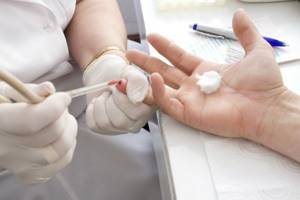
- Apply a sponge with an antiseptic to the damaged area.
After taking blood for testing, it is necessary to hold a piece of cotton wool at the puncture site so that the blood clots and there is no hematoma.
In the second option:
- a medical laboratory assistant disinfects the skin on the elbow with an antiseptic;
- using a vacuum syringe, pierces the epidermis and venous vessel;
- selects 10 ml of liquid connective tissue;
- The puncture is pressed down with a cotton swab dipped in wine alcohol.
All about children
Normally, granulocytes are absent in a general blood test, with the exception of the presence of immature neutrophils in newborns and pregnant women. That’s when immature granulocytes (young) come to their aid, which are detected in a general blood test (shift to the left). Since immature granulocytes do not live long in the blood and mature quickly, their number is small.
Granulocytes are a subgroup of granular leukocytes, which include neutrophils, eosinophils and basophils. Their norm is 50-80% of all white blood cells, in quantitative terms - 2-7X10⁹ per liter. Under a microscope you can see granules or grains in them, hence the name.
In a blood test, neutrophils are in order (from left to right): young, band and segmented. If young neutrophils are present in greater than normal numbers, this may indicate an inflammatory process or infection.
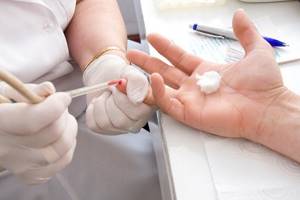
There are fewer neutrophils in the blood of a child than in adults. This indicates the development of a pathological process in the body. That is why the body begins to produce neutrophils in large quantities in order to protect against infection. Hence the large percentage of young forms. The reasons for the increase in the number of immature neutrophils are numerous. The number of rod and immature forms increases sharply.
Preparation
GRA in a blood test is an important indicator of the condition of the human body.
In order to obtain a reliable research result, it is necessary to follow the preparation rules:
- Blood sampling should be done in the morning;
- a few days before the procedure, you need to stop eating fatty foods;
- Before the examination, the following should be excluded from the diet 24 hours before the examination: alcoholic beverages; intense muscular loads; use of pharmacological drugs;
- in the morning, before donating blood, you can only drink water;

- It is not recommended to carry out a laboratory procedure after: physiotherapeutic treatment; Ultrasound; reflex effects on the tissues of the anterior and posterior parts of the body; fluorography;
- re-evaluation of leukocyte parameters must be done in the previous laboratory at the same time;
- liquid connective tissue must be taken for examination before starting treatment or 2 weeks after the end of therapy;
- it is necessary to inform the laboratory doctor about the presence of systemic pathologies.
Normal levels of immature granulocytes in a child and an adult
If you know what it means when immature granulocytes are elevated, it will be much easier to decipher your test results and, if necessary, speed up an appointment with a specialist. Granulocytes are a subgroup of granular leukocytes. It is normal if the blood contains from one to five percent of young neutrophils, eosinophils and basophils.
A slight increase in this indicator is considered normal for pregnant women and newborns. Hematocrit is an indicator in a blood test that shows the percentage of formed components. If it is elevated or decreased, it means that not everything is in order with the body. Read about the signs and treatment methods for iron deficiency anemia in our article. One thing is for sure: she is enjoying life to the fullest and is actively pursuing her career.
A clinical blood test is a reliable and informative indicator of a person’s health status. The first cells that notice abnormalities in the body and encounter infection are granulocytes. Granular leukocytes (granulocytes) are a subgroup of white blood cells that are characterized by the presence of irregularly shaped nuclei and the presence of granules (grains). Granulocytes are produced in the bone marrow and have a fairly short lifespan.
Norm
The leukogram has a certain percentage of different types of formed cells.
Standards:

The GRA norm in a blood test is shown in the photo.
| Indicator name | Children | Men | Women |
| Neutrophil leukocytes |
| 46-71% | 47-72% |
| Segmented eosinophils |
| 0-5% | 1-5% |
| Granulocytic basophilic leukocytes |
| 0,5-1% | 0-0,5% |
Granulocyte test
Each subspecies takes an active part in recognizing and protecting the body from pathogenic microflora. An increased level of young granulocytes indicates an inflammatory process in the body or the first response of the immune system to an infection. The number of granular granulocytes in an adult varies from 45 to 70%. The norms for children are somewhat different and depend on the age of the child. Granulocyte indices do not depend on gender.
In the activity of granulocytes, everything is also not always simple and smooth. Overall, automated counting of immature granulocytes means that the number of blood smears can be reduced and the labor required for manual counting can be reduced. If neutrophils are elevated, a shift to the left is usually observed in the leukocyte formula. That is, immature and band-nuclear granulocytes are present in the blood.
